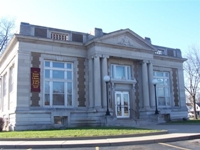 The Library Board is ready to ask the City Council next Tuesday to approve the sale of $35 million in bonds to pay for upgrades to Peoria’s library system, including building a new branch in far north Peoria.
The Library Board is ready to ask the City Council next Tuesday to approve the sale of $35 million in bonds to pay for upgrades to Peoria’s library system, including building a new branch in far north Peoria.
You may have heard the library’s director Ed Szynaka on the radio recently giving an update on where the library is in the process. It’s been a long year. The library has completed the programming phase of the process, and now they’re working on negotiating a site for the north branch. Negotiations will be more meaningful if they are able to talk real money, which is why they want the council to okay the bond issuance.
I got a chance to talk to Gary Sandberg, City Council liaison to the Library Board for this project. Everyone knows the library board had a couple of missteps early in the process, but Gary got them to agree to go through a deliberate and open process.
He showed me how they developed criteria for what features a new library site would need, and then went out and found sites that met the criteria to varying degrees. They put all that data in a matrix and ranked the sites by how well they met the criteria. The most favored site before this process (old K’s Merchandise building) came in third or fourth. The top two sites identified, as mentioned in the paper today, were the old Festival Foods store on Knoxville in Northpoint shopping center, and a greenfield site just north of Route 6 on the west side of Allen Road, behind the new Sud car dealership. I was pleased to see the sites were selected on a rational and objective basis.
But that’s not the end of the story. Next comes cost. Just because a site meets the criteria doesn’t mean that a fair price will be able to be negotiated for it. The asking price for the Festival Foods site is approximately $4 million. The Sud site is $5.50 per square foot developed (i.e., with roads, utilities, etc. built out to the property line). The Library Board will be trying to negotiate a lower price. The more they have to spend for land, the less they have to spend on construction.
The Festival Foods site is terribly overpriced. In fact, the owner of Festival Foods reportedly had been asking a little less than $2 million for the site before the library showed interest. It has certainly sat vacant long enough while other big box stores have been passing it by, searching for greener pastures (literally) farther north. Fortunately, they’re not the only site the library is considering.
This may come as a surprise to some of my readers, but I would prefer a standalone building for this project, which in this case would most likely mean a greenfield development on the Sud property. The reason is that this is a civic building, and the architecture of civic buildings is symbolic. It symbolizes the civilization of a city. When you put a library in a strip mall, it says something about your community’s values, or at least about how much your community values (a) libraries, and (b) civic architecture.
Look at the other libraries in the system. Consider the Lincoln Branch. Here, you have a Carnegie library building proudly placed in the middle of a civic square. It’s inspiring and set apart from the surrounding architecture. You know immediately that this is someplace special. It’s not a title loan place or a pizza joint. It’s a civic building. It is important. The architecture and setting reinforce that importance.
Now I realize that not every library is going to look like a Carnegie library building. That’s not my point. My point is that it’s distinguishable. The McClure branch, which is more modest architecturally, is nevertheless a distinguishable and inspiring civic building. That’s what we should be shooting for in the north end, too.
The paper says the cost of the bonds to homeowners would be “about $50 per $100,000 of assessed property value a year.” That may be, or it may be lower. Because of the way the economy is, the city may be able to get an even lower rate for the bonds; instead of $0.15 per $100 assessed value, it may only be $0.13, in which case the cost to taxpayers would only be about $43 per $100,000 of assessed property a year.
Also, it should be noted that the $35 million in bonds isn’t just for a new north branch. Only about $11 million is going toward that. The $35 million is also going to triple the size of the Lincoln branch (they’re going to build a large addition), completely remodel the Main branch (also close to $11 million), and expand the Lakeview branch as well.
*Lincoln branch picture courtesy of PeoriaIllinoisan, via his Name This Peoria Landmark blog.


 Intrepid news director at WCBU 89.9 FM, Jonathan Ahl, has
Intrepid news director at WCBU 89.9 FM, Jonathan Ahl, has  In 2006,
In 2006,  Four parents representing the District 150 Watch group met today with Peoria Public Schools Superintendent Ken Hinton to present their alternatives to shortening the school day. You can
Four parents representing the District 150 Watch group met today with Peoria Public Schools Superintendent Ken Hinton to present their alternatives to shortening the school day. You can  The City of Peoria will hold a community forum on June 2, 2008, at 6:00 p.m., to give the community the opportunity to have input about a new logo for our City. The forum will be held at the Peoria Civic Center in Room 220.
The City of Peoria will hold a community forum on June 2, 2008, at 6:00 p.m., to give the community the opportunity to have input about a new logo for our City. The forum will be held at the Peoria Civic Center in Room 220. The city’s Traffic Commission is considering lowering the speed limit from 30 to 25 miles per hour in residential neighborhoods and subdivisions. The cost would be about $200,000 to purchase new signs.
The city’s Traffic Commission is considering lowering the speed limit from 30 to 25 miles per hour in residential neighborhoods and subdivisions. The cost would be about $200,000 to purchase new signs.  The Library Board is ready to ask the City Council next Tuesday to approve the sale of $35 million in bonds to pay for upgrades to Peoria’s library system, including building a new branch in far north Peoria.
The Library Board is ready to ask the City Council next Tuesday to approve the sale of $35 million in bonds to pay for upgrades to Peoria’s library system, including building a new branch in far north Peoria.